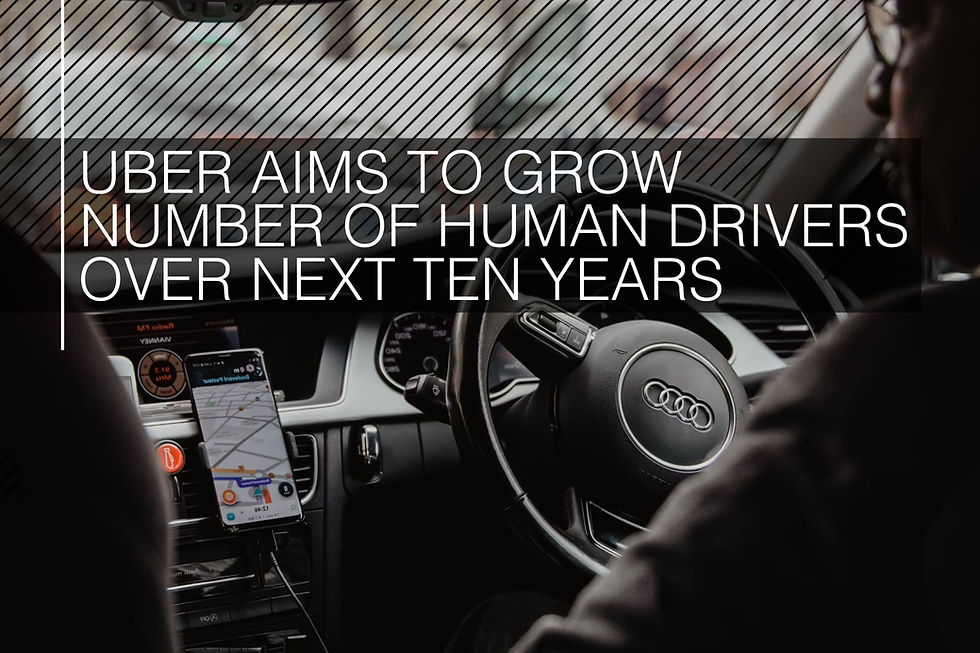Uber predicts number of human drivers WILL GROW in next ten years as operator prepares for self-driving London trials
- Perry Richardson

- Jun 23
- 3 min read

Uber has confirmed its intention to grow both its human driver base and autonomous vehicle (AV) fleet, as it prepares for public road trials of fully self-driving cars in London.
The company says it expects to have more drivers on its network in ten years than it does today, despite its commitment to expanding the use of AVs across its platform.
The comment from an Uber spokesperson comes alongside the launch of a partnership with UK-based technology firm Wayve, which will see Level 4 autonomous vehicles tested on London’s public roads. These trials mark the UK as Uber’s most significant declared AV testing ground so far and are viewed as a key step in the company’s long-term strategy to develop a hybrid network of both AVs and human drivers.
Wayve’s self-driving system is powered by what it calls an “Embodied AI” platform. This technology enables vehicles to learn from real-world driving experiences and adapt to highly dynamic urban environments. The system will now be integrated with Uber’s transport network as both firms seek to deploy AVs at scale across Europe in the coming years.
However, the announcement has reignited long-standing concerns within the taxi and private hire industry over the future of human driving jobs. Industry representatives and driver groups have warned that the rise of self-driving technology could eventually displace large numbers of professional drivers, especially in major urban centres where AVs are likely to be deployed first.
While Uber insists that human drivers will remain a critical part of its network for the foreseeable future, there remains some concern that the hybrid model may be transitional, rather than permanent. Questions remain over what balance will be struck between human and autonomous services in the years ahead, and whether drivers will be gradually phased out as AVs become more capable and widespread.
Adding to this tension is the speed at which regulatory changes are being introduced. The UK Government recently confirmed a new fast-tracked legal framework to allow commercial self-driving pilots to begin by spring 2026. The Department for Transport has committed to supporting industry trials, with the aim of turning the UK into a global hub for AV development and deployment.
Transport Secretary Heidi Alexander said the agreement between Uber and Wayve represents a strong vote of confidence in the UK’s self-driving ambitions. She noted that the Government expects the sector to generate 38,000 jobs and contribute £42 billion to the economy once commercial rollout begins.
Before trials can start, Uber and Wayve will need to work closely with both the Department for Transport and Transport for London to meet safety and regulatory requirements. The London setting is expected to provide valuable data due to its varied road layouts, dense traffic and complex rules—conditions that differ significantly from the largely grid-based layouts of US cities where most Level 4 testing has occurred.
The use of AVs in the capital is also likely to test public acceptance and raise further questions over liability, insurance, and the role of human oversight in mixed traffic conditions. While the technology is advancing, full autonomy in open public environments still faces considerable legal and operational hurdles.
For Uber, the trials represent a continuation of its long-term investment in automation. However, the company’s emphasis on a hybrid future may be an attempt to ease industry and public concerns over job displacement, as well as signal its willingness to operate under emerging UK rules rather than challenge them.
An Uber spokesperson told TaxiPoint: "We believe that 10 years from now we will have more drivers on our network than we do today. Looking ahead, we expect that the number of human drivers and AVs on the platform will continue to grow, side by side, for the foreseeable future as we continue scaling a hybrid network that combines both."








